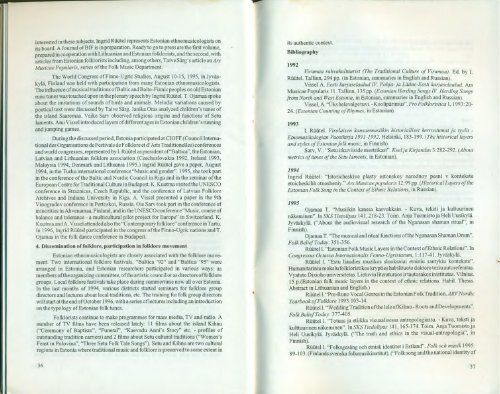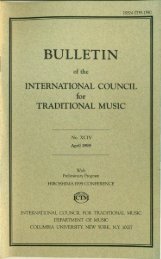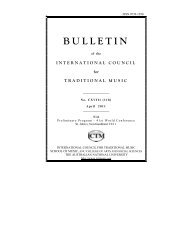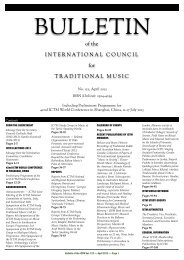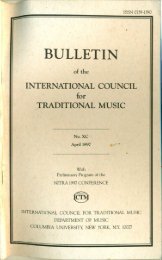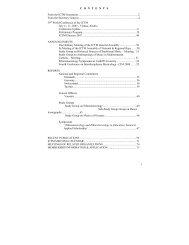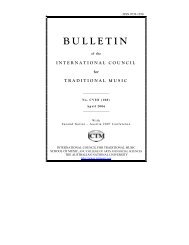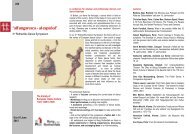Oct 1996 - International Council for Traditional Music
Oct 1996 - International Council for Traditional Music
Oct 1996 - International Council for Traditional Music
- No tags were found...
You also want an ePaper? Increase the reach of your titles
YUMPU automatically turns print PDFs into web optimized ePapers that Google loves.
origin of some children's games in Bulgaria) spoke about games related to ritual inBulgaria, bridging the survival of ritual features. Monika Fink. (DerKinderball- oderdie Tradition des Gesellschaftstanzes im 18. und 19. Jahrhundert) presented a wellresearchedhistorical tracing of children's balls ofthe 18th-19th centuries in Germany,Austria, France, England and the United States that were meant to imitate the balls ofadults. In this way the upper class children were introduced to adult social societalbehaviors at a young age. Georgina Gore (Learning language through dance: rhythm,rhyme, song and dance in French nursery education) presented a case study of dancemovement as a means to pre-school education in developing basic skills <strong>for</strong> writing.Twenty papers were given under the them of "Dance and style." One of theprimary intents of this theme was to explore the various levels of meanings of "style"in hopes of developing a usable standard definition. However, by the end of thesymposium we found that there were such ranges of meanings that it was not possibleto make a working definition nor subject keyword with a consistency of meaning.Although there was a desire to develop a means to verbalize "style", the term is toointuitive in our communication. The last day of the symposium provided a summaryof the papers, and here the discussants, Anna Starbanova, Georgina Gore, DariusKubinowski and Andriy Nahachewsky offered various views ofthe papers that werepresented. This report draws upon and selects some points of their discussion: Styleis a way of comparing and distancing; style is not describable, but is observed; styleis at the edge of consciousness, is implicit rather than explicit; style is an embodiedexperience.Conceptually, what is style?Andriy Nahachewsky in his pre-theme presentation with film/video clips(Removing the bride's veil: stylistic variation in a Ukrainian wedding ceremony)showed us the same moment in ten examples of a wedding. His point was to notesimilarity in the meaning and context, but differences in <strong>for</strong>m which is (quantitativeand measurable) structure and (qualitative and emotional) "style". AdrienneKaeppler's keynote <strong>for</strong> this theme (Dance and style) made her point that dance (shedefines as a structured movement system) is not a universal term and that dance andthe social order shape each other overtime. As in Poland two years ago, she presentedus with another "Star Trek" clip, this time showing a robot (named "Data) learning todance. She noted that cultural values must be taken in consideration in using terms suchas dance and that style is a "distancing device"; it needs geographical and locationcontrasts. Hannah Laudova (Style in folk dance tradition) suggested that style is anabstraction of authentic movement. Colin Quigley ("Incorporating style:"hermeneutic phenomenology and stylistic analyses) in preparation <strong>for</strong> a discussionround table, in<strong>for</strong>mally interviewed several members of the Study Group be<strong>for</strong>e thescheduled discussion, revealing that "style" is personally recognized as an embodiedmovement characteristic.Style as an ethnic identity markerAnca Giurchescu (Gypsy dancing: markers of an ethnic dance style asexpressed by the dance per<strong>for</strong>mers themselves) spoke about the "Gypsy style" in theRomanian context; here the style is relative to a segregated ethnic identity. She spokeabout the Romanian "hora" dance which is not perceived as a Gypsy dance in Romanianeither by the Gypsies nor by the Romanian population at large, but the Gypsyper<strong>for</strong>mance and musical rendition of the dance is noted as having a "Gypsy style."YvonneHunt (One dance, many styles) made a similar point - a dance with an identicalstructure throughout much of Greece, has different names and types of per<strong>for</strong>mances18by groups in different locales, each differentiated by a local style. Maria Koutsouba(Dance styles as an indicator of regional identity: lemonia dance of Lefkada versuskontoula lemonia dance ofEpirus, Greece) analyzed the micro movement differencesofa dance motif as per<strong>for</strong>med on an island in contrast to the mainland version. KariMargrete Okstad (Style in the work with Norwegian folk dance- methods and results)analyzed the "swikt" a vertical movement by dancers, that distinguishes the styledifference in the dancing movement. Tvrtko Zebec (Differences and changes in style:the example ofCroatian dance research) points out the importance ofCroatian "style"as an important cultural and national identity marker in the recent post independenceperiod. While Mohd Anis Md Nor (Blurring images, glowing likeness: a dichotomyof styles in the traditional dances of Malaysia) points out the opposite in hispresentation in that there is a growing sameness in the dance presentations no matterwhatthe ethnic background ofthemulticultural populations in the post colonial period<strong>for</strong> the realization of a Malaysian identity.Historical contrasts of past to presentEach noted style changes in a time framework, influenced by events in thosecountries. Stanislav Duzek (Zu den Stiliinderungen im Volkstanz in der Slowakei) ina Slovakian context, Maria Susana Azzi (The Tango) in Argentina, and DaliaUrbanaviciene (The influence of stage dance on authentic styles of folk dance) inLithuania. Similarly Martina Pavlicova (The style offolk dance and its developmenton the example of exceptional dancers from south and east Moravia) noted theimportance of an extraordinary dancer who over time set a standard <strong>for</strong> the per<strong>for</strong>manceofa particular male solo dance. Jiang Dong (Feng Xian Gong: a new classicaldance from the old Chinese tradition) points out that in China per<strong>for</strong>mers aredeveloping a "new" classical dance <strong>for</strong>m based on historical sources. Contextualcontrast ofa ritual was presented by Arzu Oztiirkmen (Different generation, differentstyles: Alevi Semah per<strong>for</strong>mances in their changing context). She pointed out the"difference in a sameness" with rural, urban, and university groups each having itspresentation style of Alevi rituals.Methodological approaches were presented by Darius Kubinowski (Interpretationof cultural patterns of dance in individual dance behaviors, the case of oberek).Involving music relationships in their approaches - Jan-Petter Blorn (A comparativephenomenology of rhythms: problems of theory, terminology, and notation in thestudy of music-dance interface), Jorgen Torp (The relative "pause" in tango-dancing)who analyzed the music/dance relationship with a movement pause (cessation ofmovement) improvised by the dancer; and Daniela Stavelova (The influence ofmusical accompaniment on creation of dance style <strong>for</strong>mation and trans<strong>for</strong>mation)showed in a Czech example a change of dancing style due to the changes ofinstrumental accompaniment.Three papers that were not directly tied to the themes of the symposium, butwere nevertheless interesting contributions. Laryssa Saban (The tanok in westernUkraine) gave a descriptive paper and video examples of tanok as a genre ofmovement, text and music. Roderyk Lange (The muses and the dance) was not present,but his paper raised issues and a rebuttal to a paper which was presented atthe previoussymposium in Poland by Professor Jan Steszewski. Zhou Bing (Eight trigrams andaesthetic factors of Chinese dance), interprets dancing movements from ancientdiagrams. Her knowledge (and demonstration) of circular gestures and turningmovements were related to the design and path of the signs.The working language of the symposium was English, but thanks to members19


